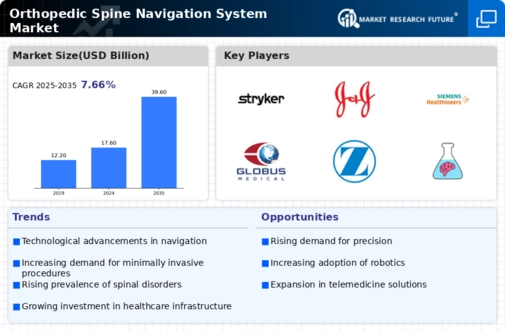Market Growth Projections
The Global Orthopedic Spine Navigation System Market Industry is projected to experience substantial growth over the next decade. With a market value expected to reach 17.6 USD Billion in 2024 and 39.6 USD Billion by 2035, the industry is poised for significant expansion. The anticipated CAGR of 7.66% from 2025 to 2035 underscores the increasing demand for advanced navigation systems in orthopedic surgeries. This growth is driven by various factors, including technological advancements, rising healthcare expenditure, and the increasing prevalence of spine disorders. The market's trajectory suggests a robust future for orthopedic navigation solutions.
Technological Advancements
The Global Orthopedic Spine Navigation System Market Industry is experiencing rapid technological advancements, particularly in imaging and robotic-assisted surgery. Innovations such as augmented reality and 3D imaging enhance surgical precision and outcomes. For instance, systems that integrate real-time imaging with navigation tools allow surgeons to visualize the spine's anatomy more accurately. This trend is likely to drive market growth, as hospitals increasingly adopt these advanced technologies to improve patient care. The market is projected to reach 17.6 USD Billion in 2024, indicating a strong demand for cutting-edge navigation systems.
Increasing Healthcare Expenditure
Healthcare expenditure is on the rise globally, which positively impacts the Global Orthopedic Spine Navigation System Market Industry. Governments and private sectors are investing more in advanced medical technologies to enhance healthcare delivery. This trend is particularly evident in developed regions, where healthcare budgets are expanding to accommodate innovative surgical solutions. As a result, hospitals are more likely to invest in orthopedic spine navigation systems, which are essential for improving surgical outcomes. The market is projected to grow to 39.6 USD Billion by 2035, reflecting the increasing financial commitment to advanced healthcare technologies.
Rising Incidence of Spine Disorders
The Global Orthopedic Spine Navigation System Market Industry is significantly influenced by the increasing prevalence of spine disorders, including degenerative diseases and injuries. As the global population ages, the incidence of conditions such as herniated discs and spinal stenosis rises, necessitating more surgical interventions. This growing patient population creates a robust demand for effective surgical navigation systems. With the market expected to grow at a CAGR of 7.66% from 2025 to 2035, the need for advanced navigation solutions becomes increasingly critical to address these health challenges.
Enhanced Training and Education Programs
The Global Orthopedic Spine Navigation System Market Industry is benefiting from enhanced training and education programs for healthcare professionals. As surgical techniques evolve, ongoing education is crucial for surgeons to stay updated on the latest navigation technologies. Institutions are increasingly offering specialized training programs that focus on the use of advanced navigation systems, thereby improving surgical proficiency. This emphasis on education not only boosts the adoption of these systems but also ensures better patient outcomes. As more surgeons become adept at using these technologies, the market is likely to see accelerated growth.
Growing Demand for Minimally Invasive Surgery
There is a notable shift towards minimally invasive surgical techniques within the Global Orthopedic Spine Navigation System Market Industry. These procedures offer numerous benefits, including reduced recovery times, less postoperative pain, and lower complication rates. As patients increasingly prefer these less invasive options, the demand for navigation systems that facilitate such surgeries is likely to rise. Surgeons are adopting advanced navigation tools to enhance the precision of minimally invasive procedures, thereby improving patient outcomes. This trend is expected to contribute significantly to the market's growth trajectory in the coming years.






















Leave a Comment